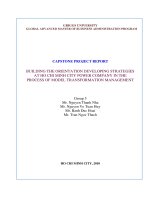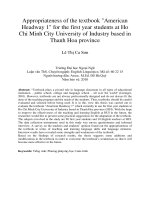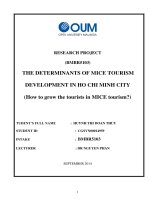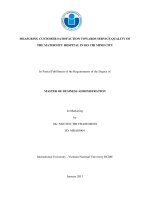The reflection on the utilization of communication strategies of the english majors at ho chi minh city open university
Bạn đang xem bản rút gọn của tài liệu. Xem và tải ngay bản đầy đủ của tài liệu tại đây (490.35 KB, 13 trang )
The Reflection on the Utilization of
Communication Strategies of the English Majors
at Ho Chi Minh City Open University
Bui Do Cong Thanh
Ho Chi Minh City Open University, Vietnam
Abstract
Reflective deployment of communication strategies to
ensure the sustainability in communication is a
cornerstone in the development of learners’ second
language L ’s strategic competence. That real-life
communication in L2 is problematic and diverse requires
learners to execute every possible survival strategy to
successfully encounter performance problems. The paper
is aimed at observing how English majors from
DH15AV56 and DH14AV44 classes at Ho Chi Minh City
Open University (HOU) make use of their L2
Communication Strategies in language classrooms. The
findings enable language teachers to elaborate on the
potential consciousness of L2 learners in their adoption of
communicative strategies and take into account the
possibility of incorporating those communication
strategies into their actual language teaching programs so
as to foster the students’ motivation, fle ibility and
strategic competence in using L2 at their levels in
response to a pressing communicative need despite their
restricted L2 linguistic resources.
Keywords: strategic competence; communication strategies;
communication breakdown; linguistic resources; language/ linguistic
inputs; learner output; cross-cultural differences; motivation; second
language acquisition (SLA)
HCMC Open University TESOL Conference Proceedings 2016
133
Introduction
In the context of globalization, Vietnam is on the threshold of cultural,
economic and educational integration in which English is regarded as
the global language and its acquisition is of great necessity in pursuit of
cultural integration and career promotion. In recognition of its crucial
importance, students at HOU, especially English majors, demonstrate
their increasing needs for English language acquisition. As real-life L2
communication is problematic and varied, language classrooms do not
generally prepare students to cope with performance problems. That is
to say, students often find themselves hard to get across their intended
meaning through real-life communication. Such an issue accounts for a
dearth of essential L2 linguistic resources to thoroughly transfer their
message to the interlocutor. In order to achieve desired communicative
goals, they attempt to take advantage of a range of communication
strategies at their levels, which involve verbal and non-verbal means of
dealing with difficulties and breakdowns that may occur in daily
communication. Reflection on the complications of real-life
communication in L2 and HOU English majors’ varied deployment of
communication strategies enables language teachers generally to
provide an extensive strategy instruction in line with the formal
provision of L2 linguistic knowledge to be well-prepared for their
students to overcome communication breakdown.
Communication Strategies in SLA– a Conceptual Framework
Communication Strategies and Strategic Competence
The term “communication strategy” was coined by Selinker, 1972 and
expeditiously captured the interest of many language researchers in
exploring how learners use L2 in their real-life communication to
achieve their ultimate goal of getting their meanings across.
First of all, strategies are, according to Nunan (1999), “the mental and
communicative procedures learners use in order to learn and use
language”. Thus, the greater awareness of strategies underlying
learning learners have, the more effective they will be at not only
knowing what but also knowing how.
Second, due to a lot of public attentions towards the term initially
134
HCMC Open University TESOL Conference Proceedings 2016
introduced by Selinker (1972), the definition of “communication
strategy” has been extensively modified. To start with, Varadi (1973)
realizes that L2 errors may take place either accidentally or
intentionally. That L2 errors arise accidentally is the result of learners’
production strategies and thereby indicates the
transitional state of
learners’ L2 knowledge along the interlanguage continuum. However,
if L2 errors are made intentionally, they are the result of
communication strategies which are consciously used by learners so as
to avoid, compensate or retrieve some element of meaning or form in
their initial plan of conveying the meanings. Consciousness is a
recognizable characteristic of communication strategies; however, the
definition still leaves a gap as to whether a strategy is conscious or
subconscious until Faerch and Kasper (1980) expand the definition by
attributing communication strategies to “potentially conscious plans for
solving what to an individual presents itself as a problem in reaching a
particular communicative goal” (Faerch
Kasper, 1980, p. 81). The
reason for this expansion is that learners may not realize their use of
communication strategies.
Corder (1977) presents his definition on communication strategies as
being problem-oriented. That is a technique employed by learners to
express their intended meanings in the face of their lack of L2 linguistic
resources to carry out the production plan. Learners’ efforts in
demonstrating communication strategies are recorded as a short-term
solution to a problem (Ellis, 1985).
Being further discussed in psycholinguistics, communication strategies
are defined by Tarone, 1981 as a mutual attempt of two interlocutors to
negotiate an agreement on meaning. That is to say, Tarone’s definition
is limitedly aimed at the interaction in which there exists a negotiation
of meaning between interlocutors. However, his interactional definition
is inoperable in monologue as Faerch and Kasper (1983c, 1984) point
out and because communicative problems still “occur in monologue as
much as in dialogue” (Ellis, 1985, p. 182).
As learners make use of communication strategies to smooth away their
communication breakdowns owing to their insufficiency of linguistic
HCMC Open University TESOL Conference Proceedings 2016
135
knowledge required for expressing their ideas, communication
strategies are considered to be closely related to strategic competence,
part of communicative competence critically framed by Canadian
applied linguists Canale and Swain (1980). Strategic competence is
seen as “verbal and nonverbal communication strategies that may be
called into action to compensate for breakdowns in communication due
to performance variables or to insufficient competence” (Canale
Swain, 1980, p. 30). To be precise, it involves survival strategies such
as avoidance, paraphrase, substitution, word coinage, repetition, nonverbal signals, etc. (Savignon, 1983). This competence plays a pivotal
role in relation to the other components of communicative competence:
grammatical competence, sociolinguistic competence and discourse
competence (Canale & Swain, 1980; Canale, 1983) with a view to
equipping learners with some of the coping or compensation strategies
to get over communication breakdowns.
On the whole, foregoing debates in an attempt to shed light on the
problems of definition help adequately clarify the term as
psycholinguistic plans which exist as the language user’s strategic
competence. They reflect the two fundamental features: potential
consciousness and problem orientedness (Ellis, 1985) and accredit
learners’ attempts to “enhance the effectiveness of communication”
(Canale, 1983, p. 11).
Typology of Communication Strategies
On account of the complexity of definition, there is no unanimity on a
standard typology of communication strategies. Various models have
been proposed by Varadi (1973), Tarone (1977), Corder (1978c), and
Faerch & Kasper (1980). Moreover, typologies regarding lexical
problems are framed by Blum-Kulka & Levenston (1978), and
Paribakht (1982). Table 1 is a summary of the typology of
communication strategies provided by Faerch & Kasper (1984; as cited
in Ellis, 1985, p. 184-185). Nonetheless, the typologies of
communication strategies suggested before Faerch & Kasper (1984)
focused
on
product-oriented
and
surface-level
features
(Kumaravadivelu, 1988) whereas subsequent research conducted by
136
HCMC Open University TESOL Conference Proceedings 2016
Bialystok & Kellerman (1987), Bialystok (1990), Dornyei & Scott
(1977), and Kumaravadivelu (1988) aimed at digging deeper into deeplevel psychological processes. Table 2 demonstrates communication
strategies which were conceptualized by Bialystok & Kellerman (1987)
and encompassed conceptual and linguistic strategies.
In addition, stalling or time-gaining strategies are often employed by
L2 learners in real-life communication to keep the communication
channel open in the face of difficulties. In fact, they are not utilized to
compensate for any linguistic deficiencies. However, many linguists
such as Hatch (1978), Canale & Swain (1980), Savignon (1983),
Haastrup & Phillipson (1983), Ellis (1985), and Rost (1994) reach an
agreement on the significance of using fillers and hesitation devices to
sustain communication in time of waiting for the items to come to
learners. Rost (1994; as cited in Dornyei, 1995) embedded the
deployment of using conversational fillers in his typology of
communication strategies to foster learners’ strategic competence.
Fig. 1. Communication Strategies as conceptualized by Faerch &
Kasper, 1984
HCMC Open University TESOL Conference Proceedings 2016
137
Table 1: Communication Strategies as conceptualized by Bialystok
& Kellerman, 1987
Conceptual Strategies:
refers
to
the
manipulation of the
target
concept
by
making it expressible
through
available
linguistic resources
Analytic Strategies involve selecting criterial
properties of the referent
E.g.: a machine that cooks and defrosts very
fast by means of waves for microwave
Linguistic Strategies:
refers to the use of
learners’ first language
(L1) and L2 linguistic
knowledge
Morphological Creativity involves the
creation of a new word by applying L2
morphological rules to a L2 word
E.g.: vegetarianist for vegetarian
Holistic Strategies involve using a similar
referent
E.g.: stove for microwave
Transfer from another language
E.g.: coffee spoon for tea spoon
The Role of Communication Strategies in SLA
Some people who have a limited command of L2 knowledge are still
able to communicate by using their gestures, imitating the sound or
movement of things, describing things in such a simple way or mixing
languages, etc. They are making every possible effort to use
communication strategies to attain their ultimate goal of
communication. The insufficiency of L2 linguistic knowledge enables
them to “communicate within restrictions” (Savignon, 1983, p. 43) by
deploying strategies to maintain communication. Such strategies keep
communication going and L2 language users take risks with their
language as Hatch (1978; as cited in Ellis, 1985) asserts that the most
important thing of all has to be “don’t give up”.
Corder (1978c) refers to avoidance strategies as “risk-avoiding” and
achievement strategies as “risk-taking”. In most cases, risk-taking,
according Faerch & Kasper (1980), is a rudimentary condition for
communication strategies to have a potential learning effect and thus,
helps learners expand their linguistic resources. In this respect, learners
are willing to make optimal use of their available linguistic knowledge to
actively contribute to keeping their communicative channel open.
138
HCMC Open University TESOL Conference Proceedings 2016
Kumuravadivelu (2006) regards communication strategies as one of the
tactical factors that “help learners pay attention to potentially useful
linguistic input and also promote opportunities for negotiation thereby
activating necessary cognitive processes” (Kumuravadivelu, 2006, p. 38).
Classroom Observation - Results and Discussion
Classroom observation was conducted in two different-level classes at
HOU, the Faculty of Foreign Languages. The observation was made on
33 intermediate-level students at DH15AV56, and 40 upperintermediate-level students at DH14AV44. The students at DH15AV56
were given a speaking task on the role of mass media in social life to
discuss in groups of three. And those at DH14AV44 were requested to
work in groups of four to talk about factors affecting work
performances. After a ten-minute group discussion, each group
member has to raise his or her ideas about the issues given. Their
speaking performance was recorded for the analysis of the deployment
of communication strategies.
The result shows that in my sample of 73 subjects, there are nine major
strategy types utilized as follows: lexical avoidance, syntactic
avoidance, phonological avoidance, paraphrase, literal translation,
non-verbal signals, restructuring, retrieval strategies and stall or timegaining strategies.
The frequent choices of strategies of the students at DH15AV56 are
lexical avoidance, syntactic avoidance, phonological avoidance, literal
translation, non-verbal signals and time-gaining strategies. Their
choices of strategies, to a certain extent, reflect their entry level in SLA.
They are likely to use more avoidance strategies to be secure enough in
communication. According to Tarone (1977), the less able students
preferred avoidance to achievement strategies. Besides, more L1-based
strategies such as literal translation and foreignizing are employed,
which demonstrates their restricted L2 linguistic resources.
With respect to the students at DH14AV44, they are recorded to use
more L2-based strategies, namely paraphrase and restructuring; nonverbal signals; retrieval strategies and time-gaining strategies. Their use
of paraphrase reveals that their L2 knowledge is in progress. This
phenomenon was also justified by Ellis, 1983 through his longitudinal
study on learners of different linguistic capabilities. He found that his
HCMC Open University TESOL Conference Proceedings 2016
139
learner had a tendency to oft for avoidance-type behaviour in the earlier
stages, and gradually through learning he turns to more achievementtype behaviour. According to Bialystok (1983b; as cited in Ellis, 1985)
advanced learners use more L2-based strategies such as paraphrase than
less advanced learners. In support of Bialytok (1983b), Haastrup &
Phillipson (1983) posit that paraphrase is the strategy most likely to be
successful.
Principles for Language Pedagogy
Such observation on how the students from two classes make use of
communication strategies in their production plan leads the author to
the strong belief that there is a practical necessity for the incorporation
of communication strategies into L2 language instruction. Despite
considerable controversy over the teachability of communication
strategies to learners over the years, certain pedagogic precepts should
be taken into careful consideration to enhance students’ communicative
competence, particularly strategic competence.
First of all, the major task of the teachers is to help learners attain a
desired level of linguistic and pragmatic knowledge in response to their
needs, wants and real-life situations. Therefore, in order to promote L2
development, the conversion of language input into learner output is
the bedrock of L2 instruction. Nevertheless, “language input should be
linguistically and cognitively accessible to learners” (Kumaravadivelu,
2006). Based on Krashen’s Comprehensible Input Hypothesis,
comprehensible input is considered the input that secure the semantic
meaning and contain the structure which is a little higher than the
students’ current level (I + 1). He argues that I +1 is a prerequisite for
language learners to be successful in L2 learning. In other words,
comprehensible input helps learners navigate on the L2 developmental
route with the help of more capable instructors or peers in order to
jump from the current level up to the potential level in accordance with
the Zone of Proximal Development conceptualized by Vygotsky. This
leads the writer to proceed with the second precept: negotiated
interaction, negotiated interpretation and scaffolding.
The initiation of negotiated interaction and interpretation in language
classrooms is of great importance as it entails learners’ active
engagement in communicative activities in which communication
140
HCMC Open University TESOL Conference Proceedings 2016
problems are negotiated between interlocutors. Hence, negotiated
interaction stimulates comprehension and production on the L2
developmental route (Kumaravadivelu, 2006). In line with the
opportunity to interact, learners should be well-equipped with cultural
norms of interpretation to prevent pragmatic failure in communication
(Thomas, 1983, as cited in Kumaradivelu, 2006). Negotiated
interaction and negotiated interpretation serve as a scaffolding to
activate psycholinguistic processes.
The third precept lays its emphasis on meaningful interactional
activities which are vital for L2 development. Vygotskyan sociocultural
theory highlights the substantial role of interaction in language
classroom. In support of this approach, it is argued that socio-cultural
theory has the greater potential with a primary emphasis on the
collaborative nature in meaning making in discourse, not just in
exchanges where communication breakdown occurs (Ellis, 1999).
Being an “activity organizer” (Tudor, 1993, p.24), the teacher should
provide a wide variety of activities in which accuracy, fluency and
overall communicative skills are embedded through instruction that is
predominantly meaning-based first and form-based later (Lightbown &
Spada, 1990, as cited in Kumaravadivelu, 2006). In all likelihood,
learners will try to deploy a far wider repertoire of their language and
experiment with or take risks with language they are not certain of as
long as their meanings can be got across. Most importantly, meaningful
interactional activities should be constructed on the selection of topics
from learners as Slimani (1989; as cited in Kumaravadivelu, 2006)
argues that learners gained more benefits from self- or peer- nominated
topics than from teacher nominated topics. That is to say learner-topic
control would create a better opportunity for them to digest the
linguistic complexity of the input at their own level and negotiate
meaning during the interaction (Ellis, 1992).
Last but not least, teachers generally should keep it in mind that learner
errors are just a natural, inevitable and essential part of the acquisition
process. They reflect the stage of development the learners have
reached. To put it another way, learner errors are a manifestation of
each L2 developmental stage in which learners make an active
contribution to acquisition. Thus, not all learner errors should be
corrected, and those that are corrected should usually not be treated
immediately (Klapper, 2006).
HCMC Open University TESOL Conference Proceedings 2016
141
Implications for English Language Teaching (ELT)
In compliance with the four pedagogic precepts mentioned above,
language teachers should be mindful of their responsibilities to
facilitate L2 development not only by providing learners with necessary
language inputs through negotiated interaction but by prompting them
to take enormous advantage of communication strategies to develop
their strategic competence in using L2 in and outside the classrooms.
PEDAGOGIC
PRECEPTS
IMPLICATIONS
Teachers should
1. The conversion of
language input into
learner output is
the bedrock of L2
instruction.
1. offer students comprehensible inputs and have
them work on these inputs for language use in
negotiated interaction and negotiated interpretation.
2. The initiation of
negotiated
interaction and
interpretation in
language
classrooms is of
great importance
as it entails
learners’ active
engagement in
communicative
activities in which
communication
problems are
negotiated between
interlocutors.
3. facilitate negotiated interaction in which learners
have more freedom and flexibility to control their
talk. Only through negotiated interaction do learners
can boost their comprehension and attempt to
restructure their interaction with their interlocutors
until mutual comprehension is met.
142
2. contextualize linguistic inputs as language is
more than a system. It should be treated far more as
discourse. This calls for the contextualization of
linguistic inputs so that learners can maximize the
language use for interaction with those inputs.
4. increase students’ motivation and build up their
positive attitude towards learning situation in which
shared decision-making is implemented to decide
how learning and teaching should be organized.
Teachers can appreciate their students’ effort of not
giving up in any interactive situation by using
communication
strategies
to
sustain
the
communication.
5. highlight
cross-cultural
differences
in
communication strategies use, especially in
employing non-linguistic strategies as in some
cultures, the same gestures can convey different
meanings. Some of indications can be negative and
impermissible. If learners are not well-prepared or
untrained for that, they will fail to get their intended
meanings across.
HCMC Open University TESOL Conference Proceedings 2016
3. Meaningful
6. maximize learning opportunities, make learning
interactional
more enjoyable and enrich the learning environment
activities are vital in such a way that is “challenging, personally
for
L2 relevant, accepting and supportive” (McCombs,
development.
1997, p.54).
7. encourage students to be willing to take risks and
make good use of communications strategies.
Teachers offer them a chance to experiment with the
language they are not sure of. In other words,
students can exploit their available linguistic
resources without having any fear of making errors
to express their ideas freely despite lack of required
linguistic inputs. If so, it can help improve their
flexibility in using L2 knowledge for achieving their
desired communicative goals.
8. provide opportunities for practice in strategy use
through meaningful learner-learner, learner-teacher
interaction in language classrooms. An increase in
strategic competence helps students get over
inhibitions when they are involved in real-life
communication in L2.
4. Learner errors are
just a natural,
inevitable and
essential part of the
acquisition
process.
9. offer them plenty of opportunities to use their
language in the classroom in a supportive
atmosphere in which rewards successful use and
does not penalize unavoidable failings in accuracy.
10. raise students’ awareness about the role of
communication strategies to readily encounter most
of the difficulties in L2 real-life communication and
that they already possess their communication
strategies in L1. Teachers should also sensitize them
to the appropriate situations in which they can find
communication strategies actually work to get their
intended meanings across.
Conclusion
The communication strategy use of HOU English majors at
DH14AV44 and DH15AV56 has been placed under critical reflection
through classroom observation and findings discussion in order to serve
the ultimate purpose of this paper that underlies the viable
HCMC Open University TESOL Conference Proceedings 2016
143
incorporation of communication strategies into L2 instruction along
with the formal provision of L2 linguistic knowledge for learners
generally. In the face of much debate over the teachability of
communication strategies in ELT, it is imperative that learners be wellequipped with communication strategies training so that they can
sustain real-life communication with more ease. The conceptual
framework on communications strategies and strategic competence
serves as a basic premise that generates and shapes language teachers’
pedagogic precepts on how to integrate communication strategies in
their practical classroom instruction to illuminate their actual teaching
practices. The job of teaching is that of creativity, variety, flexibility
and adaptability in which the teacher plays a tremendous role in
fostering the learners’ learning outcomes and - most importantly of all their notable success in L2 real-life communication.
References
Canale, M., & Swain, M. (1980). Theoretical bases of communicative
approaches to second language teaching and testing. Applied
Linguistics, 1, 1-47.
Canale, M. (1983). From communicative competence to
communicative language pedagogy. In J.C. Richards & R. W.
Schmidt (Eds.), Language and Communication (p. 2-27). Harlow,
England: Longman.
Dornyei, Z. (1995). On the teachability of communication strategies. In
TESOL Quarterly, 29(1), Spring 1995.
Ellis, R. (1985). Understanding Second Language Acquisition. Oxford:
Oxford University Press.
Ellis, R. (1999). Learning a Second Language through Interaction.
Oxford: Oxford University Press.
Faerch, C. & Kasper, G. (1980). Processes in foreign language learning
and communication. nterlanguage Studies Bulletin 5: 47-118
144
HCMC Open University TESOL Conference Proceedings 2016
Klapper, J. (2006). How students learn languages: Insight from SLA. In
Understanding and Developing Good Practice. CiLT. pp 45-70.
Kumaravadivelu, B. (2006). Understanding Language Teaching: From
Method to Post-method. Mahwah, NJ: Lawrence Erlbaum
Associates.
McCombs, B. L. & Whisler J. S. 1997. The Learner-centered
Classroom and School: Strategies for Increasing Student
Motivation and Achievement. San Francisco: Jossey-Bass
Publishers.
Nguyen, T.T. (2010). Incorporating Culture into Language Teaching in
Vietnam. Tre Publisher. HCM City.
Nunan, D. (1999). Second Language Teaching & Learning. Canada:
Heinle & Heinle Publishers
Savignon, S. J. (1983). Communicative Competence: Theory and
Classroom Practice. Reading, MA: Addison-Wesley.
Tudor, I. (1996). Learner-centredness as Language Education.
Cambridge: Cambridge University Press.
Willis, D. & Willis, J. (2007). Doing Task-based Teaching. Oxford:
Oxford University Press
HCMC Open University TESOL Conference Proceedings 2016
145









